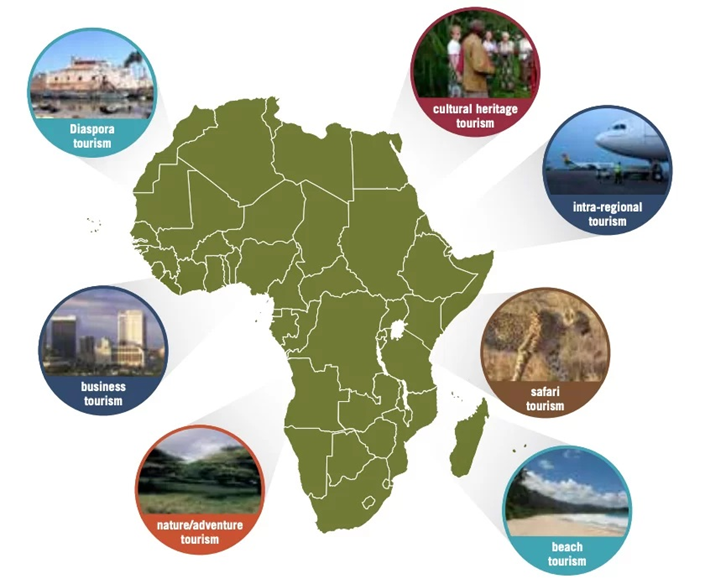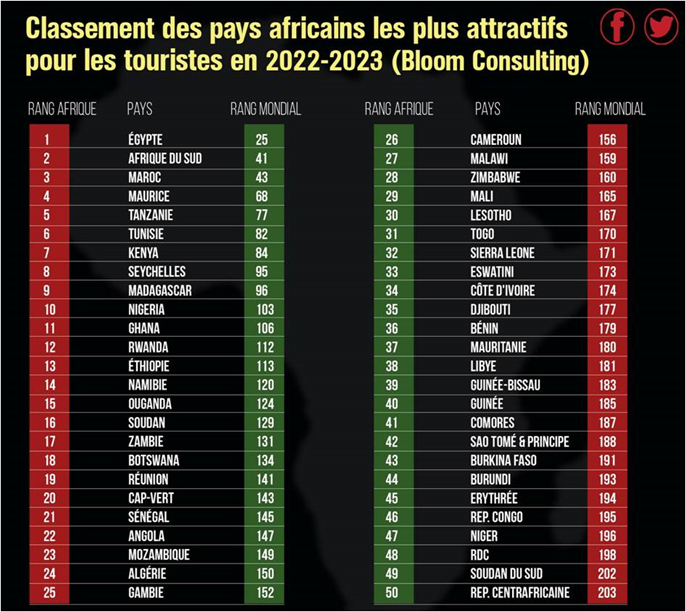Tourism in Africa continues to grow. International visitors to the continent were 37 million in 2003 and 65.3 million in 2014; the corresponding turnover is $43.9 billion in 2013. The top tourist destinations on the continent are, in order: Morocco, Egypt, South Africa, Tunisia and Zimbabwe.
Africa is a continent on the move; beyond the burden of development and government failures, nature and culture combine to create a timeless appeal for historians and a museum for travelers’ curiosity. The continent is home to multitudes of archaeological sites, historical monuments, beautiful coastlines, breathtaking landscapes, mountains, waterfalls, lush vegetation and wildlife. Africa is a great jewel yet to be discovered, filled with abundant and diverse terrestrial and aquatic wildlife. Although tourism continues to grow in Africa, the continent ranks quite low compared to other regions of the world.
In 2019, UNWTO recorded 1.5 billion international tourist arrivals worldwide, of which Africa captured only 6%, compared to 51% captured by Europe and 25% by Asia-Pacific. In the same year, the continent captured only 3% of global tourism spending. In 2019, tourism represents approximately 10.4% of global GDP. Tourism is a vital sector in many African economies. The tourism market is a gold mine of prospects and potential that Africa has yet to maximize.
Tourism contributes to job creation and economic diversification. It is a labor-intensive sector, which can provide jobs for both skilled and unskilled workers. On the continent, where unemployment rates remain the highest in the world, tourism remains a job-creating sector and helps combat poverty.
Rural areas where poorer communities are concentrated have a comparative advantage in attracting tourism, with local people potentially well-placed to offer high-demand tourism products such as music, handicrafts and guided tours.
Mauritius, South Africa, Seychelles, Morocco, Namibia, Kenya, Tunisia, Cape Verde, Botswana and Tanzania are the most competitive African countries in terms of travel and tourism.
The main tourist sites that are most popular on the continent are: Mauritius, Seychelles, Lake Victoria Falls in Zimbabwe, the Spice Islands of Zanzibar in Tanzania, Serengeti Park in Tanzania and Kenya, the Great Mosque of Kairouan in Tunisia, the Kalahari Desert in Botswana, Jamaâ El Fna Square in Marrakech in Morocco, Kruger National Park in South Africa and the Pyramids of Giza in Egypt.
Africa has enormous potential for expanding products that are currently in high demand, such as ecotourism, adventure tourism, cultural tourism, and health and wellness tourism.
Some countries are ahead of others in tourism development. Indeed, the expansion of tourism in sub-Saharan Africa faces many obstacles; there are issues related to security and peace, constraints related to access to finance for investors, a low level of tourism skills, and insecurity of infrastructure. The tourism sector in sub-Saharan Africa must remain competitive thanks to:
- Adequate infrastructure
- The skills of officials and employees with whom tourists deal
- The quality of its tourist heritage
- High-quality accommodation
- Reliable and safe domestic and international transportation
- The welcome given to tourists by local populations
- Destination security
For more information :
- https://fr.wikipedia.org/wiki/Portail:Afrique
- https://en.wikipedia.org/wiki/Africa
- https://africacenter.org/
- https://journals.openedition.org/etudesafricaines/
- https://etudes-africaines.cnrs.fr/
- https://journals.openedition.org/etudesafricaines/
- https://www.afdb.org/fr/documents-publications/economic-perspectives-en-afrique-2024


